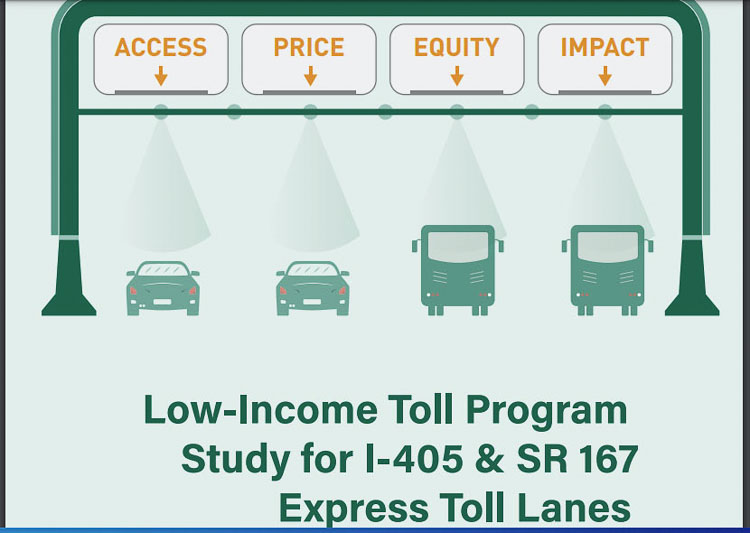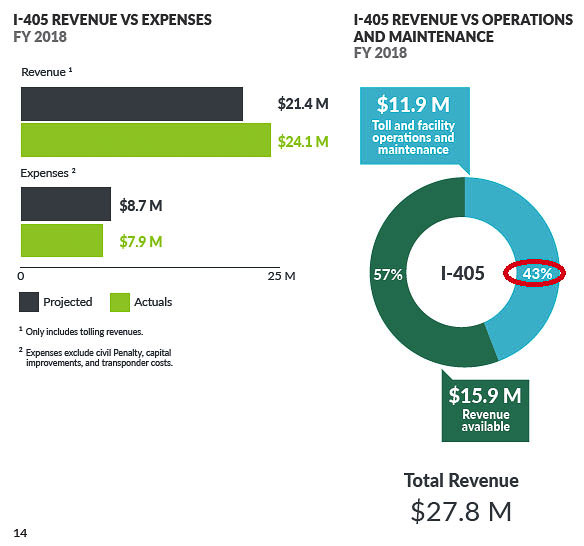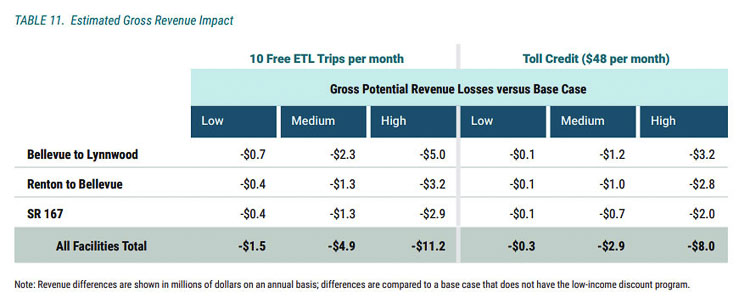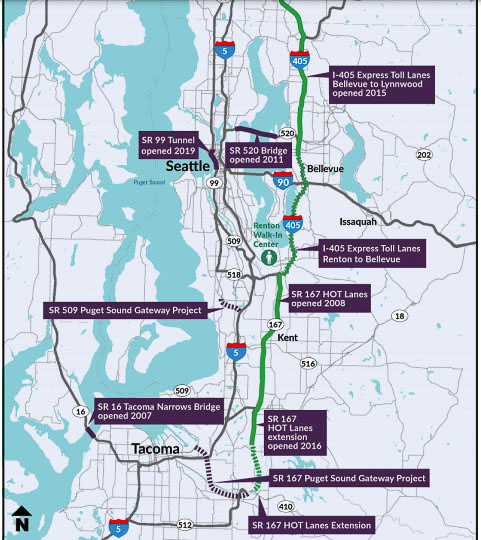WSTC raises tolls by 15 percent while studying low income tolling program
More than 59,000 vehicles used Seattle’s Express Toll Lanes (ETLs) each weekday in 2019, prior to significant declines due to the pandemic lockdown. Prices vary by time of day and by the amount of vehicle congestion. Prices go up when there are more vehicles on the road in the “congestion pricing” program. Since opening, the express toll lanes have generated $66.8 million for I-405 improvements through 2019.
On Aug. 24, the Washington State Transportation Commission (WSTC) voted to raise tolls by 15 percent on Oct. 1 for Seattle’s SR 99 tunnel, and an average of 15 percent on SR 520 beginning July 2023. For the Tacoma Narrows Bridge, the commission raised the toll by 25 cents beginning Oct 1.
A few days later, the WSTC published their Low-Income Tolling Program Study for I-405 and SR 167 ETLs. The legislature previously allocated $250,000 of tolling revenues to study how this might be accomplished. Those ETL’s are often known as “Lexus Lanes,” or as Vancouver Councilor Bart Hansen called them, “roads for the rich.”
“The advancement of such programs are a necessary step in the evolution of our state’s taxation and revenue generation structures,” said Roy Jennings of Clark County. He serves as chairman of the WSTC. Previously, he served as the labor representative on the C-TRAN Board of Directors.
The low income program could reduce tolling revenues by up to 20 percent, depending on assumptions for plan participation and system revenues.

This is of interest to Clark County and Southwest Washington residents because Oregon is implementing tolling on both I-5 and I-205 later this decade beginning “at the border” of Washington. The Oregon Department of Transportation (ODOT) has established “equity” committees to give citizens input on how tolling can be more equitable for low income and minority communities.
Earlier this week, Congresswoman Jaime Herrera Beutler (3rd Congressional District) expressed her concerns over Oregon’s congestion pricing tolling plans.
“Councilors Paulsen and Hansen reportedly took issue with the unfairness of ‘congestion pricing’ and the difficulties such a system causes for low-income workers, most of whom cannot be flexible when they commute. I have long contended that congestion pricing will amount to a deeply regressive tax, with the poor subsidizing the wealthy who are far more often able to adjust their commute times to lower-cost, lower-traffic periods.”
In the failed Columbia River Crossing (CRC) effort, tolls were expected to be up to $8 each way, in order to pay off an estimated $1.4 to $1.5 billion in borrowed money. Forensic accountant Tiffany Couch reported “we can also confirm that the CRC finance plans call for collection of the full $5.5 billion with $3.3 billion from tolls and $2.2 billion from state and federal funding.”
Some estimates indicated that 60 percent of the tolls would be paid by Clark County and Southwest Washington residents who commute to work in Oregon. The $2,000 or more in yearly costs was deemed excessive for low income workers.
In FY 2020, I-405 tolling revenue was $21.3 million and SR 167 raked in $3.5 million for a total of $24.8 million. Prepandemic revenues in 2019 were $33.1 million for I-405 and $3.9 million for SR 167. The 33 percent drop shows the volatility of tolling dollars due to changing demand and economic circumstances.
Low income toll program
The WSTC hired a consultant team led by WSP USA to conduct technical work and to prepare the low income toll program report. WSP is the same consultant firm managing the Interstate Bridge Replacement Program, and is also working for ODOT on Oregon’s tolling program.
Nationally, there are very few discount toll programs. The WSTC report identified one toll discount program in Virginia providing a fixed discount of 75 cents per trip after the first eight trips per month, and a program in the Los Angeles area offering a one-time toll credit of $25 with waiver of a monthly $1 administrative fee. In addition, a Minnesota program offering annual toll credits to drivers with low incomes was proposed in 2017 but awaits authorization to implement.
There were also at least four tolling programs where a low-income toll discount program is in the planning stages. These potential programs include two in the San Francisco Bay area, one in the San Bernardino area and one in Colorado.
These tolling programs reduce tolling revenues to the state and can increase use of the tolled lanes. In a congestion pricing scheme, additional vehicles increase toll rates.

As citizens consider the options, they should keep in mind that the “cost of collection” for Washington tolling programs is expensive. During the COVID-19 pandemic and subsequent lockdowns by Gov. Jay Inslee, traffic dropped to levels that failed to cover the cost of collection and the legislature had to bail out the tolling program.
For the first six months of Fiscal Year 2021, the state tolling program lost $5 million on the I-405 and SR 167 system. The state treasurer expressed concern about the state possibly defaulting on federal TIFIA loans made for SR 520 that crosses Lake Washington. Worst among these financial problems are the I-405 HOT lanes. They experienced an 81 percent drop in tolling revenues.
In April 2018, ODOT’s Mandy Putney briefed the Southwest Washington Regional Transportation Council (RTC) on tolling programs. “Some of these scenarios might not raise much more than the cost to cover the operations of the tolling system,” she said.
The administrative costs for the I-405 ETLs have been as high as 43 percent. Therefore discounts for low income and disadvantaged citizens would be taken from the remaining funds after administrative costs were covered. That takes away from Jennings’ stated goal of raising money.
The report noted: “Current law financial commitments assume that toll revenues will be sufficient to back issuance of over $1 billion in bonds to fund corridor improvements. Recent forecasts that factor in the impact of the COVID pandemic no longer project toll revenues sufficient to fund the current law construction program. Any potential low-income toll discount program option could exacerbate the funding gap depending on how a low-income discount program is funded.”
Since there were limited existing program examples to base a possible Washington state program on, the WSP research effort shifted to assessing what could be created in the state.
One of the reports “standard program elements” was to establish a “program advisory panel” including participants of the program, that is diverse with regard to race, geography of residence, age and gender, which reports out at least annually. Yet a similar Community Advisory Committee for the Tacoma Narrows Bridge recommendation against toll increases was ignored by the WSTC when they raised toll rates this week.
A 2009 WSDOT study found that tolling could have a notable impact on families with low incomes, with significant increases in these households’ share of income going toward transportation.
A 2019 study of I-405 ETL’s indicated higher-income drivers use the facility more often than drivers with low incomes, but high-income drivers do not make up a majority of drivers. Drivers with low incomes disproportionately use the express lanes when tolls and time savings are high.

The report studied numerous options and narrowed them down to two for further evaluation.
► Fixed Number of Free Toll Trips: program participants receive 10 free express toll lanes (ETL) toll trips per month, or
► Fixed Toll Credits: Program participants receive a monthly toll credit equal to the 100 percent of the toll usage of the average ETL customer – assessed at $48 in toll credits per month.
Rough estimates were made for the costs of the program. Initial set up costs were in a range of $2.2 million to $4 million. Ongoing costs to administer the program was estimated at $1.2 million per year.
Finally, a gross revenue impact of the two programs showed giving 10 free ETL trips per month would cost (lost revenue) of $1.5 million to $11.5 million per year. For the $48 fixed toll credit program, the lost revenue ranged from $300,000 to $8 million per year. The ranges were based on low, medium, and high enrollment projections of eligible low income drivers.
After accounting for “leakage” or uncollectable tolls, they forecast a reduction of $1.4 million to $9.6 million per year for the free trips option and from $0.5 million to $6.9 million per year for the toll credits option.
The report failed to mention the revenue loss as a percentage of total tolling revenues. If they want to create a program for the poor, surely they want the most people to benefit from the program. Using medium levels of participation, the revenue losses could be between 8 percent and 15 percent for the two options considered for 2019 revenue. At 2020 pandemic levels of use, the program revenue losses could be between 12 percent and 20 percent.

Earlier this year the WSTC also suggested the legislature consider the possibility of tolling existing HOV lanes on additional freeways to provide an infusion of revenues.
Prior to 2019, ETL toll revenues were committed only to fund continued toll operations in the corridor. However, in 2019 the legislature provided authority to issue bonds to fund improvements on the I-405/SR 167 corridor.
Since then the COVID-19 pandemic reduced current and future I-405/SR 167 revenue forecasts considerably. As a result, in 2021 the legislature directed WSDOT to identify the extent of the funding gap and options for altering program schedules and/or finding additional non-toll revenues. Reports on this analysis are due by the end of 2021. “Projections of reduced net revenue have potential to widen the funding gap depending on how the discount program options are funded and implemented,” the WSP USA report states.
Implementation of a low-income discount toll program will likely put additional pressure on meeting existing I-405 ETL performance requirements during the peak periods. State and federal law sets performance standards for travel time, speed, and reliability for the express toll lanes project.
Express toll lanes must maintain speeds of 45 mph at least ninety percent of the time during peak periods. After two years of operation in 2017, the I-405 express toll lanes missed their legal requirement to move traffic. In 2019, speeds had improved and met speed goals 80 percent of the time during peak periods, yet still failing state requirements.
State law requires the toll lanes meet the 45 mph standard and collect at least enough money to meet operating costs or they “must be terminated as soon as practicable.” The WSDOT response was to expand the hours of “peak periods” so the math worked to justify keeping the tolls in place. As noted earlier, the legislature had to shore up the tolling program, which lost money due to the pandemic lockdown.




